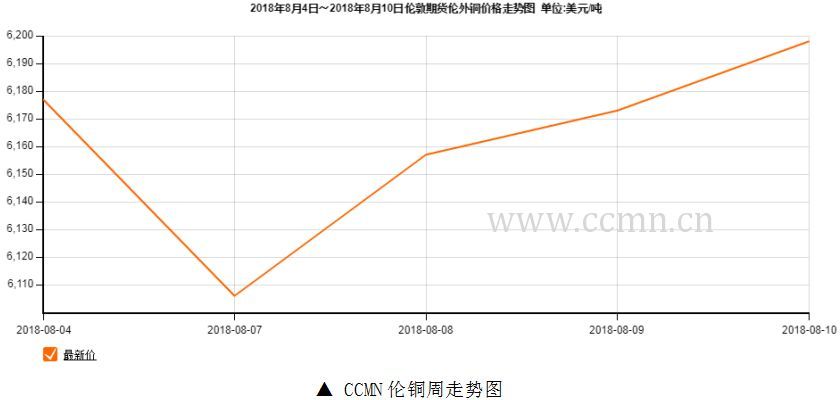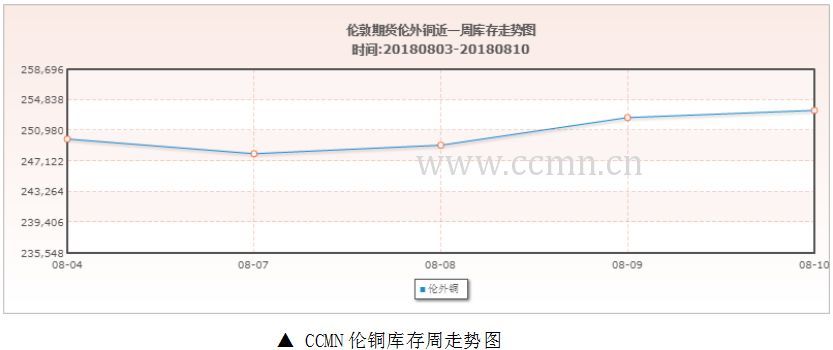Summary: As workers at the Escondida copper mine in Chile and BHP enter the final stage of negotiations, the last round of labor-management talks at the Caserones copper mine in Chile has broken down, with a strike imminent. The prospect of strikes at multiple copper mines is driving up copper prices. However, the United States and China continue to impose additional tariffs on each other, with trade tensions boosting market risk aversion and limiting the rebound in copper prices. Copper prices have seen an overall recovery this week.
1.The trend of domestic spot copper prices this week.

The world's largest copper mine, BHP's Escondida copper mine in Chile, has entered the final stage of negotiations, after workers voted down the final wage offer. BHP has requested mandatory mediation from the authorities. Meanwhile, the union at the Caserones copper mine in Chile said on Wednesday that the final round of labor negotiations with the miner Lumina Copper had broken down, and a strike was imminent. China's July CPI and PPI growth rates were higher than market expectations, with the CPI returning to the "2 era". The positive economic data, coupled with the prospect of strikes, drove up copper prices.
For the week ending August 10th, domestic spot copper prices rose overall. The average price of No.1 copper on the Changjiang Nonferrous Metals Network was reported at 49,482 yuan/ton, with a daily increase of 112 yuan/ton and a weekly increase of 1.14%. The average price for the previous week was reported at 49,576 yuan/ton, a decrease of 94 yuan/ton or 0.19% compared to the week before.
2.The weekly trend of copper futures prices.

Amid the prospect of copper mine strikes in Chile and strong economic performance in China driving up copper prices, the United States and China successively announced their second round of tariff plans. The US decided to impose a 25% tariff on 16billionworthofChineseimportsstartingfromAugust23,towhichChinarespondedbydecidingtoimposea2516 billion worth of imports from the US, to be implemented synchronously with the US. The trade war has cast a shadow over the global economic outlook, with market risk aversion rising and a strong US dollar limiting the rebound in copper prices.
According to CCMN data, LME copper futures rebounded slightly this week. The average price of LME copper futures for the first four trading days was 6,158.5perton,withadailyincreaseof5.25 per ton. The average price for the previous week was $6,201.4 per ton, representing a week-on-week decrease of 0.69%.

According to data from the China Nonferrous Metals Industry Network, this week, Shanghai copper prices rose and then fell. The current month's 1808 contract had a weekly average settlement price of 49,434 yuan per ton, with a daily average increase of 114 yuan per ton; the previous week's average was reported at 49,496 yuan per ton, a week-on-week change of 0.13%. This week, Shanghai copper inventory decreased by 21,710 tons to 171,107 tons, a decrease of 11.26%, and the cumulative decrease over the past six weeks was 35.18%.
3.Weekly inventory situation of LME copper

As shown in the figure, the inventory of LME copper increased slightly this week, with a cumulative increase of 2,900 metric tons to 253,525 metric tons, a cumulative increase of 1.16%.
4. Domestic and International Financial Highlights
Domestic:
In US dollar terms, China's import and export growth rates in July rebounded beyond expectations. Exports increased by 12.2% year-on-year, while imports surged by 27.3% year-on-year, almost double the previous value. The trade surplus was $28.05 billion.
China's CPI in July was 2.1% year-on-year, exceeding the expected 2%, compared to the previous 1.9%. China's PPI in July was 4.6% year-on-year, exceeding the expected 4.5%, compared to the previous 4.7%. Both the year-on-year increases in CPI and PPI exceeded expectations, with non-food price increases pushing up CPI, and rising oil prices driving CPI back into the "2 era".
International:
US PPI in July showed zero month-on-month growth for the first time in seven months, as moderate increases in commodity prices were offset by declines in service prices. However, excluding food, energy, and trade services, PPI continued to rise by 0.3% month-on-month, matching the previous month's growth rate.
The Federal Reserve's July Senior Loan Officer Survey showed weaker demand for residential real estate loans; consumer loan demand remained steady; lending standards for commercial/industrial loans eased; and demand for commercial/industrial loans from small businesses was stronger.
5. Copper Market Weekly Highlights
The union at the Caserones copper mine in Chile said on Wednesday that the final round of labor negotiations with the miner Lumina Copper had broken down, and a strike was imminent. The 300-member workers' union stated that during the final round of negotiations mediated by the government, Lumina, a joint venture controlled by JX Holding and Mitsui Mining, had taken a "tough" stance on their demands. If Lumina does not improve contract conditions by Friday, the strike will begin next Tuesday (August 14).
On August 6 in Santiago, miner BHP said on Monday that it had formally requested a period of government mediation during negotiations with the union at its Escondida copper mine in Chile, after workers threatened to start a strike. The union earlier requested the company to negotiate at 1400 GMT (22:00 Beijing time on Monday), but said in a statement later on Monday that it had started preparing for the strike.
6. Outlook for Copper Prices
Multiple copper mines in Chile, known as the copper kingdom, are on the brink of strikes, and Vedanta's Indian copper smelter is unlikely to resume operations in the short term. The expected tight supply in the global copper market is supporting copper prices; however, uncertainties in the international trade situation and rising expectations for Federal Reserve interest rate hikes are putting pressure on copper prices. Attention will be on the release of US July CPI later in the evening.
China's tariff list for US imports, involving $16 billion, includes US copper scrap. Currently, imports of US copper scrap account for about 20% of China's total copper scrap imports. Therefore, the tariff issue will have a significant impact on future copper scrap supply and may continue to stimulate refined copper consumption. Domestic environmental protection production restrictions are continuously being implemented, which may have an impact on both supply and demand in the copper market. China's economic data are relatively healthy, and the benefits of infrastructure investment are continuing to materialize. The trend of domestic inventory reduction remains unchanged. It is expected that copper prices are in a stage of bottoming out with fluctuations and may rebound next week.
